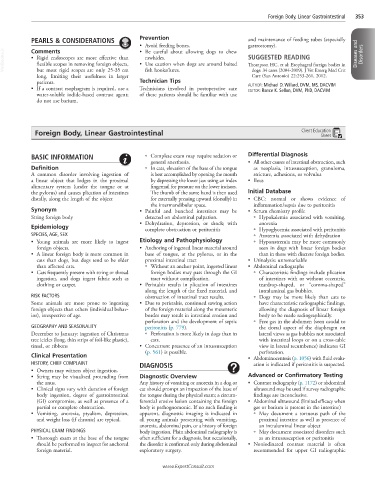Page 749 - Cote clinical veterinary advisor dogs and cats 4th
P. 749
Foreign Body, Linear Gastrointestinal 353
PEARLS & CONSIDERATIONS Prevention and maintenance of feeding tubes (especially
• Avoid feeding bones. gastrostomy).
Comments
VetBooks.ir • Rigid endoscopes are more effective than • Use caution when dogs are around baited SUGGESTED READING Diseases and Disorders
• Be careful about allowing dogs to chew
rawhides.
flexible scopes in removing foreign objects,
Thompson HC, et al: Esophageal foreign bodies in
but most rigid scopes are only 25-35 cm
Care (San Antonio) 22:253-261, 2012.
long, limiting their usefulness in larger fish hooks/lures. dogs: 34 cases (2004-2009). J Vet Emerg Med Crit
patients. Technician Tips
• If a contrast esophagram is required, use a Technicians involved in postoperative care AUTHOR: Michael D. Willard, DVM, MS, DACVIM
EDITOR: Rance K. Sellon, DVM, PhD, DACVIM
water-soluble iodide-based contrast agent; of these patients should be familiar with use
do not use barium.
Foreign Body, Linear Gastrointestinal Client Education
Sheet
BASIC INFORMATION ○ Complete exam may require sedation or Differential Diagnosis
general anesthesia. • All other causes of intestinal obstruction, such
Definition ○ In cats, elevation of the base of the tongue as neoplasia, intussusception, granuloma,
A common disorder involving ingestion of is best accomplished by opening the mouth stricture, adhesions, or volvulus
a linear object that lodges in the proximal by depressing the lower jaw using an index • Ileus
alimentary system (under the tongue or at fingernail for pressure on the lower incisors.
the pylorus) and causes plication of intestines The thumb of the same hand is then used Initial Database
distally, along the length of the object for externally pressing upward (dorsally) in • CBC: normal or shows evidence of
the intermandibular space. inflammation/sepsis due to peritonitis
Synonym • Painful and bunched intestines may be • Serum chemistry profile
String foreign body detected on abdominal palpation. ○ Hypokalemia associated with vomiting,
• Dehydration, depression, or shock; with anorexia
Epidemiology complete obstruction or peritonitis ○ Hypoglycemia associated with peritonitis
SPECIES, AGE, SEX ○ Azotemia associated with dehydration
• Young animals are more likely to ingest Etiology and Pathophysiology ○ Hyponatremia may be more commonly
foreign objects. • Anchoring of ingested linear material around seen in dogs with linear foreign bodies
• A linear foreign body is more common in base of tongue, at the pylorus, or in the than in those with discrete foreign bodies.
cats than dogs, but dogs tend to be older proximal intestinal tract • Urinalysis: unremarkable
than affected cats. ○ Without an anchor point, ingested linear • Abdominal radiographs
• Cats frequently present with string or thread foreign bodies may pass through the GI ○ Characteristic findings include plication
ingestion, and dogs ingest fabric such as tract without complication. of intestines with or without eccentric,
clothing or carpet. • Peristalsis results in plication of intestines teardrop-shaped, or “comma-shaped”
along the length of the fixed material, and intraluminal gas bubbles.
RISK FACTORS obstruction of intestinal tract results. ○ Dogs may be more likely than cats to
Some animals are more prone to ingesting • Due to peristalsis, continued sawing action have characteristic radiographic findings,
foreign objects than others (individual behav- of the foreign material along the mesenteric allowing the diagnosis of linear foreign
ior), irrespective of age. border may result in intestinal erosion and body to be made radiographically.
perforation and the development of septic ○ Free gas in the abdomen (seen caudal to
GEOGRAPHY AND SEASONALITY peritonitis (p. 779). the dorsal aspect of the diaphragm on
December to January: ingestion of Christmas ○ Perforation is more likely in dogs than in lateral views as gas bubbles not associated
tree icicles (long, thin strips of foil-like plastic), cats. with intestinal loops or on a cross-table
tinsel, or ribbons • Concurrent presence of an intussusception view in lateral recumbence) indicates GI
(p. 561) is possible. perforation.
Clinical Presentation • Abdominocentesis (p. 1056) with fluid evalu-
HISTORY, CHIEF COMPLAINT DIAGNOSIS ation is indicated if peritonitis is suspected.
• Owners may witness object ingestion.
• String may be visualized protruding from Diagnostic Overview Advanced or Confirmatory Testing
the anus. Any history of vomiting or anorexia in a dog or • Contrast radiography (p. 1172) or abdominal
• Clinical signs vary with duration of foreign cat should prompt an inspection of the base of ultrasound may be used if survey radiographic
body ingestion, degree of gastrointestinal the tongue during the physical exam; a circum- findings are inconclusive.
(GI) compromise, as well as presence of a ferential erosive lesion containing the foreign • Abdominal ultrasound (limited efficacy when
partial or complete obstruction. body is pathognomonic. If no such finding is gas or barium is present in the intestine)
• Vomiting, anorexia, ptyalism, depression, apparent, diagnostic imaging is indicated in ○ May document a tortuous path of the
and weight loss (if chronic) are typical. all young animals presenting with vomiting, proximal intestine as well as presence of
anorexia, abdominal pain, or a history of foreign an intraluminal linear object
PHYSICAL EXAM FINDINGS body ingestion. Plain abdominal radiography is ○ May document associated disorders such
• Thorough exam at the base of the tongue often sufficient for a diagnosis, but occasionally, as an intussusception or peritonitis
should be performed to inspect for anchored the disorder is confirmed only during abdominal • Noniodinated contrast material is often
foreign material. exploratory surgery. recommended for upper GI radiographic
www.ExpertConsult.com

